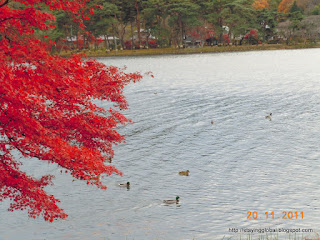Shirakawa
city is located in southern part of the Nakadori region of Fukushima
prefecture. It is about 188 kms from Tokyo and is close to the Nasu highland
area. Its location gives the city a cool climate and beautiful nature. The city
has been an important part of the history, having been the site of one of the
biggest battles during the Boshin War of 1868.
Along
with Nakoso near Iwaki city and Nesu, Shirakawa once served as an entrance to
the Tohoku region. As such Shirakawa ,
once served as one of Tohoku’s important checkpoints.Around 5th
century, a barrier was built to protect potential attacks. Today the place
remains as a reminder of the past and is a popular place among visitors.
It is
now known as Shirakawa Sekinomori Park. This was the first place that we
visited in Shirakawa city.
The park consists of a big open ground, trees and
trails, a playground and some “Visual houses”.
A long slide is the attraction of the play area, tempting even some adults to try it.
Small food joints serving
freshly made soba are popular among visitors to the Sekinomori park.
We
then drove to the Nanko park which is about 9 kms from the Sekinomori Park.
This park is considered to be the oldest Japanese style park. It was built by
Sadanobu Matsudaira, a lord , gardener and tea master.
The park covers a wide
expanse lined by cherry, maple and pine trees.
A walking path along the Oike
lake offers a good view.
The sunlight around dusk provided a golden hue to the
lake, making it picturesque.
It is said that Nanko park’s look is transformed
with every season. The Nanko Shrine stands in one corner of the Nanko park.
This shrine was built in 1922 and enshrines Sadanobu Matsudaira, the person who
built the Nanko pak.
The Suirakuen garden is located closeby. This is a
Japanese style garden and houses a Japanese style tea house called “Shusui-an”.
When
we visited Nanko park, it was the peak of autumn and the autumn foliage was at
it best.
We
then drove to the Komine castle which is a short drive from Nanko park. The
castle once served as an important part of history and is said to have been a
home to seven clans. It dates back to 1340 when it was first built. It was
rebuilt in Teikaku style in 1632. It was destroyed in 1868 during the Boshin
war, only to be rebuilt in 1991.
The castle has been a symbol of Shirakawa city
ever since. In the March 11th Great Eastern Japan Earthquake, the
castle was destroyed again. When we visited, the restoration work was in
progress and as such we could not enter the castle. The restoration work is
expected to be completed by mid December 2011 when the castle will be opened to
public again. We visited the Shirakawa Shuko-en gallery which stands on the
castle grounds.
Various exhibits are on display here.
Shirakawa
city is famous for many things. Apart from the part it has played in history,
it has been a big contributor to Japanese culture and cuisine. The Daruma dolls
of Shirakawa are famous for their unique style. The Shirakawa Daruma dolls are
made without eyes. When wishes are fulfilled, people draw the eyes.
Soba,
buckwheat noodles are a popular type of noodles in Japan. This noodle is
consumed especially during the winter as it is believed to help endure the cold
weather. Shirakawa is one of the four major Soba cities in Japan, the others
being Morioka, Izumo and Shinshu.
Each soba shop has its unique style and way of
making soba. The Shirakawa Ramen is also popular for the crunchy handmade
noodles which are used in the dish.
Hundreds of noodle shops in Shirakawa vouch
for the city’s unique Soba and Ramen culture. Nanko Dango, a local style of
dumpling is a famous confectionary from Shirakawa.
Fukushima
airport is about a 30 min drive from the city.
Access:
Shirakawa
Sekinomori Park:
Phone:
0248-22-1147
Entrance
: Free
Nanko
Park (Suirakuen): 0248-23-6888
Entrance
to Nanko Park: Free
Entrance
to Suirakuen Garden: Adult 310 yen and Students: 150 yen.
Timings:
9:00-17:00 . Closed on 2nd Wednesday of each month.
Shirakawa
Komine Castle:
Phone:
0248-24-5050
Shuko-en
gallery.
Entrance:
Adults 310 yen, Children 100 yen.
Timings:
9:00-16:30. Closed on Mondays.



















No comments:
Post a Comment